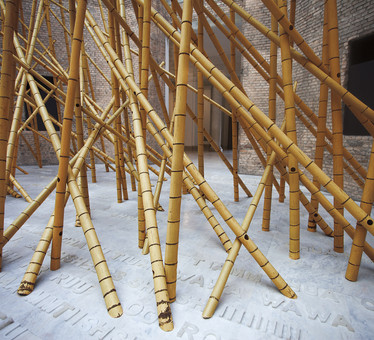José Spaniol

São Luiz Gonzaga, Brazil, 1960
Exploring the potencies of verticality and horizontality, José Spaniol’s works recreate the experience of displacement and evoke the imminence of impermanence. His works breathe a static certainty and eat to which pragmatic reality clings: they are furniture that rests and dreams, inerasable slates like true palimpsests, black granite floors that liquefy in the brightness of the light. These unusual displacements generate a feeling of estrangement and place us under new conditions of perception, in which we ignore purposes, destinations and rules. Strange and involved, we feel a distance emerging through which a thin line of discovery and indeterminacy can flow, a line that continually makes the idea of art possible and urgent.
José Spaniol was born in 1960 in the small town of São Luiz Gonzaga, Rio Grande do Sul. In 1964, he moved with his family to São Paulo and in 1978 he joined the fine arts course at Fundação Armando Álvares Penteado. Graduated in 1982, Spaniol became a professor at the same institution in 1986. In fact, his work as a professor is a striking feature of Spaniol’s trajectory and highlights, in the academic sphere, the formative sensitivity and investigative nature of the artist, who currently teaches at the Instituto de Unesp Arts.
Within Spaniol’s multifaceted production, it is possible to recognize elements and suggestions common to some works, as signs of a plastic language that develops in a coherent way. Thus, there is a dialogue between earthy works such as Mirante (1997), Tímpano (2009) and VISTA ASSIM (2010). Produced in pau-a-pique, a technique in which the earth is beaten and compacted in order to form solid and habitable structures, these strange monuments communicate intimately with the horizontality of the ground while at the same time they rise, expanding the space solemnly. Molding a reverential silence and duration around their ancestral materiality, they announce in the red of their clay something of the very essence of our flesh.
In a different sense, but with a similar record, there are aerial works, challenging in their upward balance. These are works like Ascensions (2010), Firmament (2010) and, more recently, TIAMM SCHUOOMM CASH! (2019) and Dreams of October (2019). In them, the vertical space engenders the environment of an existential reflection. Here we are dealing with the verticality that links the sub and the supra, where the artist’s interest turns to the connective dynamics of ascension and its effect on the observer. The suspension, which is materialized in such works by eucalyptus logs or long bamboo poles, is virtualized in the series The Rest of the Room (2006 – 2014), which uses the reflexivity of glass or water in a synthetic situation: placed horizontally, these mirrors open to the dreamlike verticality of floating, inverted furniture. Connection of axes and worlds that, no longer separated, reverberate a freer transit of ways of being.
GG
José Spaniol exhibition in the Metropolis program
Exhibition TIUMMMMTICHAMM by José Spaniol at Dan Galeria, on the Metropolis program on TV Cultura.
Exhibition "Line, Color and Movement"
We present Line, Color and Movement. Dan Galeria's new online collection exhibition.
Dan Galeria in the project "Arte em Campo"
Dan Galeria participates in the project “Arte em Campo” with works by Amilcar de Castro, Franz Weissmann and José Spaniol.
